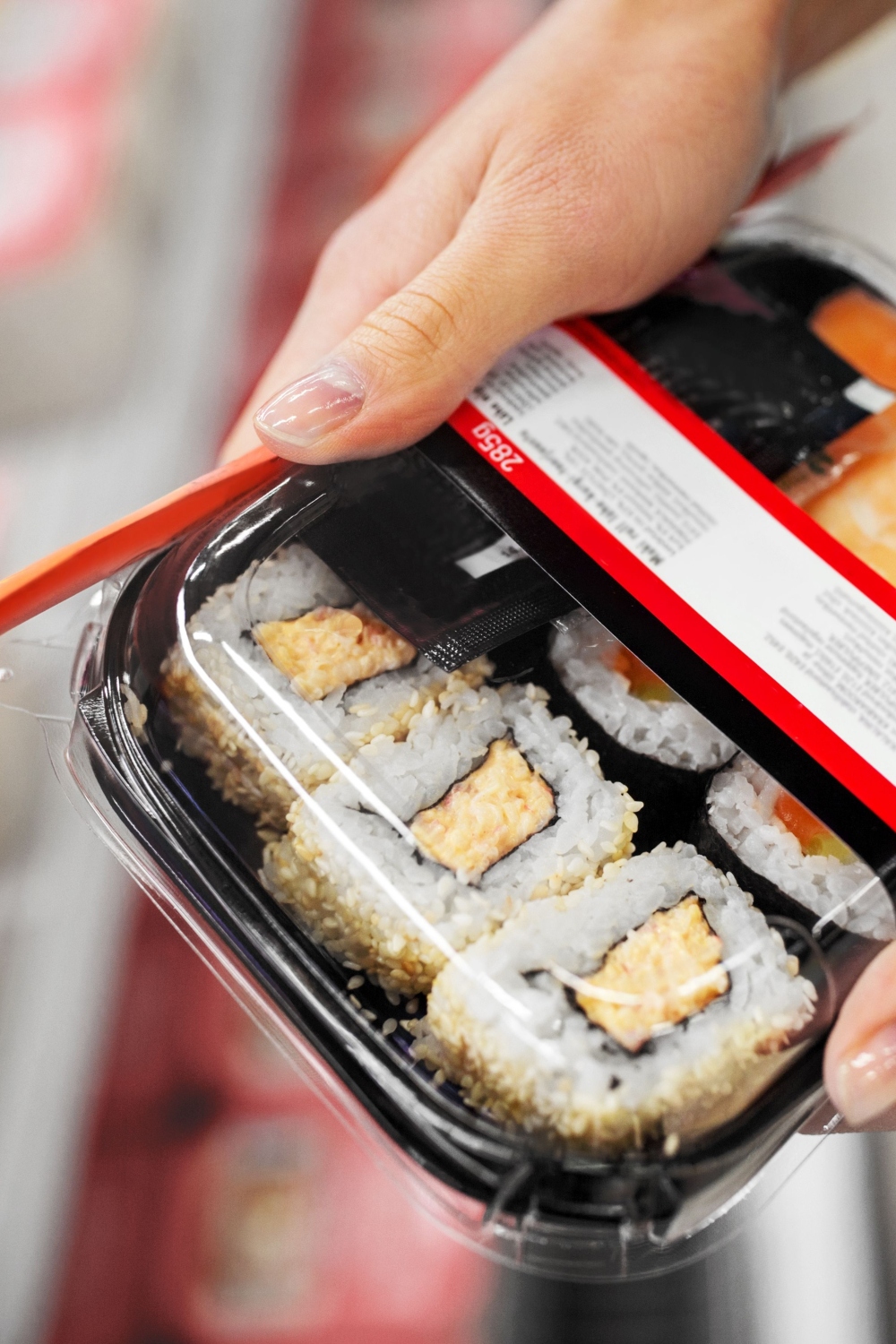In general, fish and seafood is not everybody’s thing, but a few pieces of salmon packed in rice and seaweed are always a classic that you can’t refuse.
Sushi, whether raw, cooked, or vegetarian, offers some unique flavors alongside exceptional nutrition profiles, so many people enjoy visiting traditional sushi restaurants, and some even go to Japan because of it.
The downside of sushi is the fact that it isn’t very shelf-stable, so the question of its shelf life and storage easily arises. Therefore, many people tend to wonder whether sushi can be eaten the next day.
Well, the answer is not so simple because in some situations it can, while that’s not such a good idea in others. So let’s take a look at more details because there are many variables.
Can Sushi Be Eaten The Next Day?

As I already said, sometimes you can, and sometimes you can’t. It all depends on two important factors: The type of sushi and the storage method.
If you are a fan of sushi, you most certainly know that there is raw fish sushi (like sashimi or nigiri), cooked fish sushi (like California roll, tempura roll, or snow crab roll), and vegetarian sushi (like vegetable rolls or avocado rolls).
They all have slightly different shelf lives. Namely, cooked fish sushi and vegetable sushi will last slightly longer than raw fish sushi because raw fish and seafood are extremely sensitive.
Aside from that, it is not the same if you store any type of sushi at room temperature or in the fridge.
Like many other foods, sushi has a relatively short shelf life at room temperature, while it can stay good for longer if stored at lower temperatures, i.e. in the fridge.
If you store any type of sushi at room temperature, you definitely shouldn’t consume it the next day. But if you store it in the fridge, it will be perfectly safe.
However, you should know that the quality in terms of taste and texture depends on the exact type of sushi as well as storage conditions, so let’s take a look.
So How Long Exactly Does It Last?
Aside from the fact that different types of sushi have different shelf lives, there is a huge difference between storing your sushi at room temperature and in the fridge.
Room Temperature
You must know that you can’t keep sushi leftovers out for more than 2 hours. This is especially the case if you are dealing with raw fish sushi, although it is a similar story with cooked or vegetarian sushi.
Namely, according to USDA, raw or cooked fish or seafood must not be left at room temperature for more than 2 hours because room temperature falls in the category of temperature danger zone (40°F-140°F).
Within that temperature range, harmful bacteria tend to grow rapidly after that time frame. And if it is really warm outside, i.e., if the temperature is over 90°F, 1 hour is the limit.
This is also the case with most other types of meat, including pork, chicken, or cooked chicken.
So, you should store every type of sushi in the fridge as fast as you can. When you store your sushi in the fridge, the type becomes very important.
Refrigerator
If it is raw fish sushi, you should consume it within 12-24 hours if you don’t want to get food poisoning or any other foodborne illness. So, if you stored it in the fridge early in the morning, I wouldn’t suggest you consume it the next day.
On the other hand, if you store it in the evening, you can enjoy it early the next day.
It is a bit of a different story with cooked and vegetarian sushi. In terms of safety, there is nothing wrong with keeping it in the fridge for about 3-4 days, or even a few days longer.
However, I would suggest you eat it within 24 hours as well.
But what’s the problem? Well, moisture and oxidation are the main issues.
Due to moisture migration, the seaweed will become soggy and the rice will dry up and become hard. I know that sticky rice is the worst thing that can happen, but, believe me, hard rice is not enjoyable at all.
Secondly, most types of vegetarian sushi contain avocado, so if it stays in the fridge for too long, the natural process of oxidation occurs leading to brown spots and less quality overall.
How To Store Sushi Properly?

You already know that it is best to store sushi in the fridge, but you also have to know that you can not put it in however you like, but you must learn a few storage techniques.
First things first, make sure that your sushi hasn’t been left out for more than 2 hours because no storage technique will be save it if it has.
If you ordered sushi to go from the restaurant, transfer it from the plastic or styrofoam box to an airtight container.
Airtight containers will protect it from air and moisture, consequently protecting it from early spoilage.
Make sure that the container is sealed well with ice packs. If it isn’t, air will probably penetrate and cause damage easily.
Aside from the type of container, you can also wrap your sushi in plastic wrap, foil, or moisture-proof paper. However, make sure that you do the job properly so that there are no holes through which air or moisture can penetrate.
To be 100% sure, I would recommend you to do both, i.e., wrap it tightly in plastic wrap and put the properly wrapped sushi in an airtight container.
This way, you will be sure that there won’t be any air, moisture, or cross-contamination from other foods.
Tips For Keeping Sushis Quality
Here are a few tips that can be helpful when handling and storing sushi:
• Soy sauce is an excellent preservative for sushi. Soak a paper towel and wrap the sushi tightly in it, as this will help it to preserve its freshness throughout the day.
• Before you store your sushi in the fridge, make sure to get rid of any excess water because it can speed up the molding process.
• Set the fridge temperature at 41°F because that is the ideal temperature for rice and seaweed to maintain their quality to a certain extent.
• After the refrigeration process, if you want to make your rice moist again, heat the sushi in the microwave for 30 minutes at low heat. Make sure not to microwave additional fillings like avocados, carrots, and other veggies.
• You can also bake sushi in the oven for about 8 minutes at 352°F if it has been in the fridge for 24 hours or longer. This will make it flavorful once again.
What To Avoid When Storing Sushi?
I found some sources on the internet suggesting that there are types of sushi that can be left on the counter for long periods of time.
For example, they suggest that inari sushi (which contains no fish) will be better if it is out of the fridge for longer periods of time because the vinegar preserves it.
However, although it might be a bit safer than the one that contains fish and seafood, there is not enough vinegar to protect it from spoilage for that long.
I definitely wouldn’t suggest you keep any type of sushi out of the fridge for more than 2 hours.
Now, when it comes to freezing, this method can be very beneficial for some foods, like freezing cooked chicken for example, but not for sushi.
This method will extend the shelf life of the sushi, but at what cost? Namely, sushi rice has a delicate texture, and freezing and thawing can cause it to become mushy or grainy.
Aside from that, the texture of raw fish may also change after freezing, resulting in a less desirable overall flavor profile. Finally, seaweed also doesn’t freeze well because it loses its recognizable seaweed flavor and texture.
All in all, because of safety issues, always avoid storing sushi at room temperature, and because of quality issues, do not freeze it either.
Signs That Your Sushi Isn’t Good Anymore

Remember that you are dealing with fish, one of the most sensitive food items in the world, and in most cases, raw, which is even more dangerous. Knowing the signs of spoilage is therefore a must in this case.
The first thing you should do is to do a visual test by checking the rice. If the rice is not properly stored and has been sitting in the wrong conditions for too long, it can easily become sticky to the touch, which can lead to mold growth.
So, if there’s any goo, and especially if you notice mold, it is best to get rid of that sushi in order to stay on the safe side.
The second part of the visual test is to check the fish. Namely, salmon is naturally orange in color, but if it goes bad, you will certainly notice some unusual discoloration.
When it comes to raw tuna, it has a vibrant, red coloration. However, if you notice that it is turning pinkish, get rid of that sushi because that is a sign of spoilage.
If everything looks right, your next task is to smell the sushi. Rice is a neutral grain, so it shouldn’t smell at all. However, if it develops a stale fragrance, toss it out.
It is a similar story when it comes to fish, although it does have that fishy smell to some extent. However, if it is too fishy, i.e. funky, there are most probably bacteria inside, which indicates certain spoilage.
What Are The Risks Of Eating Spoiled Sushi?
I won’t go into details, but I will say a few important facts when it comes to eating sushi, especially if it is spoiled.
First, sushi contains high amounts of mercury, a toxic heavy metal that can, when consumed in high amounts, damage several organs in your body. (1)
Aside from that, fish is more likely to contain parasites and bacteria, which can easily multiply if the sushi is not stored properly.
In that case, if you consume it, you will have to deal with foodborne illnesses or food poisoning. The most common symptoms include vomiting, diarrhea, stomach issues, and nausea.
Finally, I have to say that it is very risky to offer this type of food to those at higher risk of complications, especially if you are not sure of its freshness. Those include pregnant women, young children, and older people.
Conclusion
So, can you eat sushi the next day? You can eat sushi the next day if you store it properly in the fridge.
However, it is important to remember that you should consume raw sushi within 12-24 hours due to safety issues, and cooked or vegetarian sushi due to quality issues.
Also, take note that it is essential to avoid storing sushi at room temperature for more than 2 hours, no matter the type. Aside from that, it is not recommendable to freeze it because its quality tends to deteriorate after the process.

